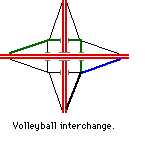The Volleyball

This interchange is better known as the 3-level diamond or split-level diamond. The term "volleyball interchange," one of my few contributions to colloquial English, will get you blank stares at a job interview, but a smile of recognition among many road fans. I'll explain how the Volleyball term applies.
All turning motions are handled in an intermediate square structure connecting the eight ramps. Turning traffic travels around the square in the same direction as a roundabout in that country. Through traffic can proceed on either intersecting road without stopping.
Driving Example
Suppose you exit northbound on the thick black ramp. To go east, you would take the blue ramp: a simple right turn. To go west (a left turn), you would take the green route, which involves merging and crossing other traffic.
"It's Yours!"
Both through roads in a volleyball interchange can be fully access controlled, although the interchange is often controlled with traffic signals. It's a little like volleyball in that each roadway handles its own freewayness, but leaves the details of the interchange to the other one -- like two players on a back line yelling "Yours!" as the ball bounces between them.
Pros and Cons
Advantages of the volleyball interchange include the ability to locate in it a narrow space along the two rights of way: more capacity than a diamond, and less space than a full cloverleaf.
Cross the volleyball with the single point urban interchange, and the result is a volleyball SPUI, or more clinically, a split-level urban diamond. At a different grade from the two crossing roads would be a signalized four-way intersection.
The volleyball's disadvantages include a large number of bridges and low capacity compared to more directional interchanges.
Variations
The four intersections where the ramps interact can be replaced with a roundabout, with the same potential advantages roundabouts bring to surface street intersections. Adam Froehlig has spotted one at US 61 and Causeway Blvd in Metairie, Louisiana (see map. This variation is much more common in Britain.
Where are they?
Volleyball interchanges are rare. A sampling includes I-29/US 77 in Sioux City, Iowa (see map) — ("Iowa's Stupidest Intersection," says a C of C map); planned for I-291/US 5/CT 15 in Newington, CT; US 75/US 82 in Texas; I-470/US 250 in Wheeling, WV; I-476/US 1 in PA. Unlike SPUI's, there is not yet a "Dr. Volleyball" with a list of these, and I'm not collecting them either.
Randy Spradling writes that the when he worked with the West Virginia DOT, the counterclockwise movements in the I-470/US 250 earned it the nickname "toilet bowl."
Links
- Interchanges
- Glossary
- Culture: interchanges in movies, computer games, etc.
- Diamond and other 4-ramp designs
- Six-ramp partial cloverleaf
- Cloverleaf
- Trumpet and other 3-way interchanges
- Stack and other heavy-duty 4-way interchanges
- Volleyball: an odd 3-level 4-way treatment
- SPUI: Single-Point Urban Interchange
- Oddities: Some strange or fictional interchanges